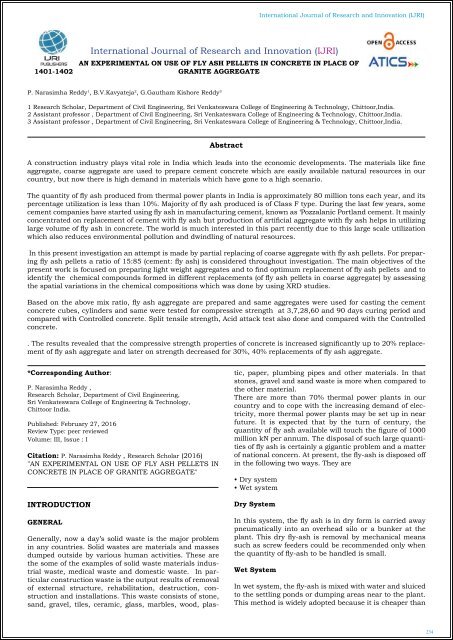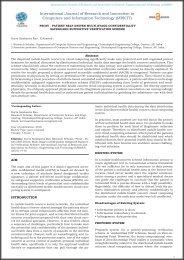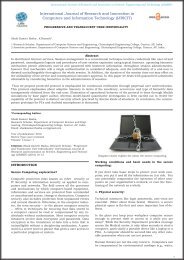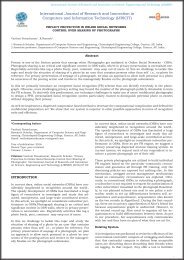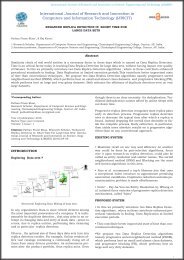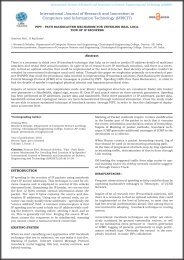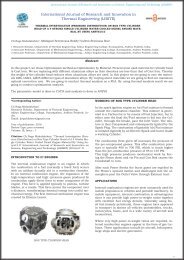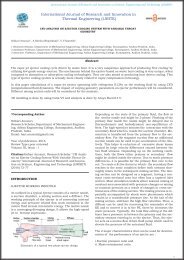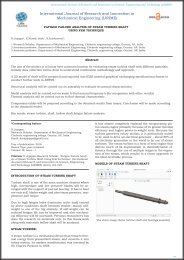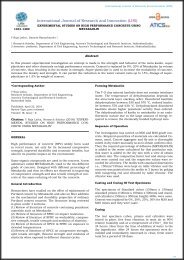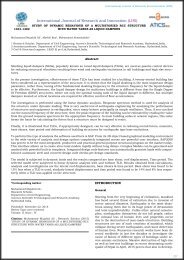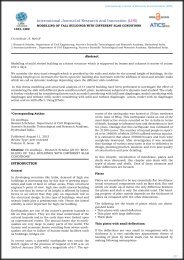AN EXPERIMENTAL ON USE OF FLY ASH PELLETS IN CONCRETE IN PLACE OF
A construction industry plays vital role in India which leads into the economic developments. The materials like fine aggregate, coarse aggregate are used to prepare cement concrete which are easily available natural resources in our country, but now there is high demand in materials which have gone to a high scenario. The quantity of fly ash produced from thermal power plants in India is approximately 80 million tons each year, and its percentage utilization is less than 10%. Majority of fly ash produced is of Class F type. During the last few years, some cement companies have started using fly ash in manufacturing cement, known as ‘Pozzalanic Portland cement. It mainly concentrated on replacement of cement with fly ash but production of artificial aggregate with fly ash helps in utilizing large volume of fly ash in concrete. The world is much interested in this part recently due to this large scale utilization which also reduces environmental pollution and dwindling of natural resources.
A construction industry plays vital role in India which leads into the economic developments. The materials like fine
aggregate, coarse aggregate are used to prepare cement concrete which are easily available natural resources in our
country, but now there is high demand in materials which have gone to a high scenario.
The quantity of fly ash produced from thermal power plants in India is approximately 80 million tons each year, and its
percentage utilization is less than 10%. Majority of fly ash produced is of Class F type. During the last few years, some
cement companies have started using fly ash in manufacturing cement, known as ‘Pozzalanic Portland cement. It mainly
concentrated on replacement of cement with fly ash but production of artificial aggregate with fly ash helps in utilizing
large volume of fly ash in concrete. The world is much interested in this part recently due to this large scale utilization
which also reduces environmental pollution and dwindling of natural resources.
You also want an ePaper? Increase the reach of your titles
YUMPU automatically turns print PDFs into web optimized ePapers that Google loves.
International Journal of Research and Innovation (IJRI)<br />
1401-1402<br />
International Journal of Research and Innovation (IJRI)<br />
<strong>AN</strong> <strong>EXPERIMENTAL</strong> <strong>ON</strong> <strong>USE</strong> <strong>OF</strong> <strong>FLY</strong> <strong>ASH</strong> <strong>PELLETS</strong> <strong>IN</strong> C<strong>ON</strong>CRETE <strong>IN</strong> <strong>PLACE</strong> <strong>OF</strong><br />
GR<strong>AN</strong>ITE AGGREGATE<br />
P. Narasimha Reddy 1 , B.V.Kavyateja 2 , G.Gautham Kishore Reddy 3<br />
1 Research Scholar, Department of Civil Engineering, Sri Venkateswara College of Engineering & Technology, Chittoor,India.<br />
2 Assistant professor , Department of Civil Engineering, Sri Venkateswara College of Engineering & Technology, Chittoor,India.<br />
3 Assistant professor , Department of Civil Engineering, Sri Venkateswara College of Engineering & Technology, Chittoor,India.<br />
Abstract<br />
A construction industry plays vital role in India which leads into the economic developments. The materials like fine<br />
aggregate, coarse aggregate are used to prepare cement concrete which are easily available natural resources in our<br />
country, but now there is high demand in materials which have gone to a high scenario.<br />
The quantity of fly ash produced from thermal power plants in India is approximately 80 million tons each year, and its<br />
percentage utilization is less than 10%. Majority of fly ash produced is of Class F type. During the last few years, some<br />
cement companies have started using fly ash in manufacturing cement, known as ‘Pozzalanic Portland cement. It mainly<br />
concentrated on replacement of cement with fly ash but production of artificial aggregate with fly ash helps in utilizing<br />
large volume of fly ash in concrete. The world is much interested in this part recently due to this large scale utilization<br />
which also reduces environmental pollution and dwindling of natural resources.<br />
In this present investigation an attempt is made by partial replacing of coarse aggregate with fly ash pellets. For preparing<br />
fly ash pellets a ratio of 15:85 (cement: fly ash) is considered throughout investigation. The main objectives of the<br />
present work is focused on preparing light weight aggregates and to find optimum replacement of fly ash pellets and to<br />
identify the chemical compounds formed in different replacements (of fly ash pellets in coarse aggregate) by assessing<br />
the spatial variations in the chemical compositions which was done by using XRD studies.<br />
Based on the above mix ratio, fly ash aggregate are prepared and same aggregates were used for casting the cement<br />
concrete cubes, cylinders and same were tested for compressive strength at 3,7,28,60 and 90 days curing period and<br />
compared with Controlled concrete. Split tensile strength, Acid attack test also done and compared with the Controlled<br />
concrete.<br />
. The results revealed that the compressive strength properties of concrete is increased significantly up to 20% replacement<br />
of fly ash aggregate and later on strength decreased for 30%, 40% replacements of fly ash aggregate.<br />
*Corresponding Author:<br />
P. Narasimha Reddy ,<br />
Research Scholar, Department of Civil Engineering,<br />
Sri Venkateswara College of Engineering & Technology,<br />
Chittoor India.<br />
Published: February 27, 2016<br />
Review Type: peer reviewed<br />
Volume: III, Issue : I<br />
Citation: P. Narasimha Reddy , Research Scholar (2016)<br />
"<strong>AN</strong> <strong>EXPERIMENTAL</strong> <strong>ON</strong> <strong>USE</strong> <strong>OF</strong> <strong>FLY</strong> <strong>ASH</strong> <strong>PELLETS</strong> <strong>IN</strong><br />
C<strong>ON</strong>CRETE <strong>IN</strong> <strong>PLACE</strong> <strong>OF</strong> GR<strong>AN</strong>ITE AGGREGATE"<br />
<strong>IN</strong>TRODUCTI<strong>ON</strong><br />
GENERAL<br />
Generally, now a day’s solid waste is the major problem<br />
in any countries. Solid wastes are materials and masses<br />
dumped outside by various human activities. These are<br />
the some of the examples of solid waste materials industrial<br />
waste, medical waste and domestic waste. In particular<br />
construction waste is the output results of removal<br />
of external structure, rehabilitation, destruction, construction<br />
and installations. This waste consists of stone,<br />
sand, gravel, tiles, ceramic, glass, marbles, wood, plastic,<br />
paper, plumbing pipes and other materials. In that<br />
stones, gravel and sand waste is more when compared to<br />
the other material.<br />
There are more than 70% thermal power plants in our<br />
country and to cope with the increasing demand of electricity,<br />
more thermal power plants may be set up in near<br />
future. It is expected that by the turn of century, the<br />
quantity of fly ash available will touch the figure of 1000<br />
million kN per annum. The disposal of such large quantities<br />
of fly ash is certainly a gigantic problem and a matter<br />
of national concern. At present, the fly-ash is disposed off<br />
in the following two ways. They are<br />
• Dry system<br />
• Wet system<br />
Dry System<br />
In this system, the fly ash is in dry form is carried away<br />
pneumatically into an overhead silo or a bunker at the<br />
plant. This dry fly-ash is removal by mechanical means<br />
such as screw feeders could be recommended only when<br />
the quantity of fly-ash to be handled is small.<br />
Wet System<br />
In wet system, the fly-ash is mixed with water and sluiced<br />
to the settling ponds or dumping areas near to the plant.<br />
This method is widely adopted because it is cheaper than<br />
234
International Journal of Research and Innovation (IJRI)<br />
any other method of fly ash disposal. It is however necessary<br />
to have the following three conditions fulfilled for<br />
satisfactory operation by this system:<br />
• Availability of large areas of waste land for ponding;<br />
• Regular emptying of filled up ponds and<br />
• Unrestricted water supply.<br />
PROBLEM STATEMENT<br />
Many studies done on fly ash aggregates fully replacement<br />
of coarse aggregate in concrete. By the replacement<br />
of fly ash aggregate saving our natural resources and less<br />
labour is used by not shipping raw material from distant<br />
places to where glass is available saving time and money.<br />
First we can prepare fly ash aggregate 15:85 ratio of cement<br />
fly ash at 0.3 water cement ratio. By the replacement<br />
of this fly ash aggregate, and a basic experimental<br />
study on the physical and mechanical properties of concrete<br />
containing fly ash aggregate was carried out.<br />
THESIS LAYOUT<br />
Chapter 2 includes general literature over view for studying<br />
the use of fly ash aggregate in engineering properties.<br />
This research highlighted the different properties of fly<br />
ash aggregate and behavior of concrete at different percentages<br />
of fly ash aggregate replacement in to that.<br />
Chapter 3 discusses scope and objective of the present<br />
project<br />
Chapter 4 displays the descriptive variables in the experimental<br />
testing considering the properties of aggregates<br />
and raw materials. This chapter states with different raw<br />
components of concrete, sieve analysis, concrete mix, the<br />
test results of concrete and compressive strength of hardened<br />
concrete. This chapter ends with a detailed list of the<br />
different proportions of fly ash aggregate used in concrete.<br />
SCOPE <strong>AN</strong>D OBJECTIVES<br />
This research is mainly focusing on studying the effect of<br />
fly ash aggregate on the properties of concrete mixtures<br />
as a partially replacement of coarse aggregate.<br />
Within the scope of this study, the main goal is to improve<br />
compressive strength of concrete at what percentage of<br />
replacement of fly ash aggregate. Fly ash is the cheapest<br />
material of all concrete constituents and is much less<br />
expensive than natural aggregate and sand as possible to<br />
save money.<br />
The main aim of the research is to study the effect of concrete<br />
when partially replacing the fly ash aggregate in to<br />
the concrete. This objective can be achieved through the<br />
following conditions:<br />
• To determine normal consistency, initial and final setting<br />
times, soundness and fineness of cement.<br />
• To study specific gravity, water absorption of coarse aggregate<br />
of normal and fly ash aggregate.<br />
• To find out specific gravity, water absorption of fine aggregate<br />
of river sand and fly aggregate.<br />
• To examine the effects of these substances with different<br />
dosages like 10%, 20%, 30% and 40% replacement of<br />
coarse aggregate by weight in the concrete cubes on short<br />
term and long term strength development by finding the<br />
compressive strength values at different ages i.e. 3 days,<br />
7 days, 28 days, 60 days and 90 days.<br />
• To assess split tensile strength of conventional concrete<br />
and partially replacement of fly ash aggregate.<br />
• To find the strength of cement concrete cubes after conducting<br />
various durability test like Acid Test<br />
• To identify the chemical compounds formed in different<br />
combinations of cement concrete by assessing the spatial<br />
variations in the chemical compositions which was done<br />
by using X-Ray diffraction studies.<br />
RESEARCH METHODOLOGY<br />
The following are to be carried out in order to achieve the<br />
research objectives.<br />
•To collect the fly ash from thermal power plant RTPP.<br />
•Prepare the fly ash aggregate at 15:85 proportions.<br />
•To study about the fly ash aggregate.<br />
•Experimental study on strength replacement of fly ash<br />
aggregate in concrete.<br />
•Analyse the experimental results to draw conclusions.<br />
MATERIALS <strong>AN</strong>D METHODS<br />
GENERAL<br />
The physic-chemical properties of cement, sand , granite<br />
aggregate and water used in the investigation were analyzed<br />
based on and the standard experimental procedure<br />
laid down in the standard codes, like IS, ASTM and BS<br />
codes. These standard experimental procedures were<br />
adopted for the determination of normal consistency,<br />
initial and final setting times, soundness of cement and<br />
compressive strength and split tensile strength.<br />
MATERIALS<br />
The materials used in the present experimental investigation<br />
include;<br />
1. Cement : Ordinary Portland cement (OPC)<br />
2. Mineral admixtures : Fly ash<br />
3. Fine aggregate : Sand<br />
4. Coarse aggregate<br />
a) Granite<br />
b) Fly ash aggregate<br />
5. Water<br />
Chemical characteristics of fly ash<br />
S. No chemical<br />
characteristics<br />
1. Silica + alumina+<br />
iron<br />
oxide % by<br />
mass<br />
2. Silicon<br />
dioxide % by<br />
mass<br />
3. Magnesium<br />
oxide % by<br />
mass<br />
4. Sulphur<br />
trioxide % by<br />
mass<br />
5. Available<br />
alkalies as<br />
sodium oxide<br />
% by mass<br />
6. Loss on ignition<br />
Requirement Composition<br />
of fly ash<br />
used<br />
70 (min) 94.2<br />
35 (min) 53.0<br />
5 (max) 1.19<br />
2.75 (max) 0.04<br />
1.5 (max) 0.46<br />
12 (max) 0.34<br />
235
International Journal of Research and Innovation (IJRI)<br />
Benefits<br />
• Reduces bleeding,<br />
• Increase time of setting,<br />
• Improve workability,<br />
• Reduces segregation in plastic concrete,<br />
• Increases ultimate strength,<br />
• Reduces drying shrinkage and permeability,<br />
• Lowers the heat of hydration<br />
Fine aggregate<br />
The sand used throughout the experimental work ws obtained<br />
from Chittoor, Chittoor district, Andhra Pradesh.<br />
Sand was thoroughly washed with tap water to remove<br />
impurities like decayed vegetable matter, humus, organic<br />
matter and deleterious materials like clay, fine silt and<br />
fine dust and was oven dried for 24 hours and cooled to<br />
room temperature and hence care was taken for the sand<br />
used in the investigation.<br />
In the present work the size of the sand is passing through<br />
4.75 and retaining on 150mm as per IS sieve. The specific<br />
gravity of sand is 2.6. sand is tested for specific gravity, in<br />
accordance with IS: 2386-1963(Part I and II)<br />
Sand Properties<br />
S.NO Properties Sand values<br />
1 Specific gravity 2.6<br />
2 Water absorption 1.0<br />
(%)<br />
3 Bulk density (Kg/ 1.460<br />
m3)<br />
4 Fineness modulus<br />
(%)<br />
3.12<br />
Compressive strength<br />
Remove the specimen from water after specified curing<br />
time and wipe out excess water from the surface. Take the<br />
dimension of the specimen to the nearest 0.2m. Clean the<br />
bearing surface of the testing machine. Place the specimen<br />
in the machine in such a manner that the load shall<br />
be applied to the opposite sides of the cube cast. Align the<br />
specimen centrally on the base plate of the machine. Rotate<br />
the movable portion gently by hand so that it touches<br />
the top surface of the specimen. Apply the load gradually<br />
without shock and continuously at the rate of 140kg/<br />
cm2/minute till the specimen fails. Record the maximum<br />
load and note any unusual features in the type of failure.<br />
Samples Testing<br />
Concrete cube specimens<br />
In carrying out the X-ray diffraction, the concrete samples<br />
are first grinded into powder form. The sample size<br />
is normally 0.002mm to 0.005 mm and then they are put<br />
into the small packets. X-ray diffraction (XRD) data for<br />
grind samples were tested on Panalytical’s X’Pert Pro with<br />
Cu Kα radiation at IIT Ropar, Punjab. The samples are<br />
scanned in the range of 2Ѳ = 5 - 60˚ at the scanning speed<br />
of 2˚/min.<br />
X-ray powder diffraction (XRD) is a rapid analytical technique<br />
primarily used for phase identification of a crystalline<br />
material and can provide information on unit cell<br />
dimensions. The analyzed material is finely ground, homogenized,<br />
and average bulk composition is determined<br />
4.4.3.1 Fundamental Principles of X-ray Powder Diffraction<br />
(XRD)<br />
Max von Laue, in 1912, discovered that crystalline substances<br />
act as three-dimensional diffraction gratings for<br />
X-ray wavelengths similar to the spacing of planes in a<br />
crystal lattice. X-ray diffraction is now a common technique<br />
for the study of crystal structures and atomic spacing.<br />
X-ray diffraction is based on constructive interference of<br />
monochromatic X-rays and a crystalline sample. These<br />
X-rays are generated by a cathode ray tube, filtered to<br />
produce monochromatic radiation, collimated to concentrate,<br />
and directed toward the sample. The interaction of<br />
the incident rays with the sample produces constructive<br />
interference (and a diffracted ray) when conditions satisfy<br />
Bragg's Law (nλ=2d sin θ). This law relates the wavelength<br />
of electromagnetic radiation to the diffraction angle<br />
and the lattice spacing in a crystalline sample. These diffracted<br />
X-rays are then detected, processed and counted.<br />
By scanning the sample through a range of 2θangles, all<br />
possible diffraction directions of the lattice should be attained<br />
due to the random orientation of the powdered material.<br />
Conversion of the diffraction peaks to d-spacings<br />
allows identification of the mineral because each mineral<br />
has a set of unique d-spacings. Typically, this is achieved<br />
by comparison of d-spacings with standard reference patterns.<br />
All diffraction methods are based on generation of X-Rays<br />
in an X-ray tube. These X-rays are directed at the sample,<br />
and the diffracted rays are collected. A key component of<br />
all diffraction is the angle between the incident and diffracted<br />
rays. Powder and single crystal diffraction vary in<br />
instrumentation beyond this.<br />
236
International Journal of Research and Innovation (IJRI)<br />
X-ray Powder Diffraction (XRD) Instrumentation<br />
X-ray diffractometers consist of three basic elements: an<br />
X-ray tube, a sample holder, and an X-ray detector<br />
RESULTS <strong>AN</strong>D DISCUSSI<strong>ON</strong>S<br />
Comparison between Compressive Strength for 0 and 20% replacement<br />
of Fly Ash Aggregate<br />
GENERAL<br />
In this chapter the parameters studied on the control<br />
concrete and fly ash aggregate replaced concrete are discussed.<br />
The parameter such as compressive strength was<br />
discussed and comparison between the control concrete<br />
and fly ash aggregate concrete is represented.<br />
Concrete is the most widely used manufactured material<br />
in the construction industry. It’s the most important<br />
property is durability which relates the performance of<br />
the material to its service life under various environmental<br />
conditions. The ability of concrete to withstand and<br />
satisfactorily and for long periods the effects of load, time,<br />
and environment depends very much on how the engineering<br />
properties of the material are constituted initially<br />
and how they are allowed to develop with age.<br />
The use of cementitious and pozzolanic siliceous industrial<br />
by-products as mineral admixtures-in concrete can<br />
bring improvements in engineering properties of concrete<br />
(strength, impermeability and general durability). Normal<br />
pozzolan additives due to their low surface area and reactivity<br />
are not generally able to improve the early strength<br />
which is crucial to the strength and stability of structural<br />
concrete applications and durability of concrete. The<br />
problem, though, could be solved by using a mixture of<br />
normal (such as fly ash, silica fume and slag) and a highly<br />
reactive pozzolan, to produce a durable concrete which<br />
does not suffer from low early strength.<br />
Comparison between Compressive Strength for 0 and 30% replacement<br />
of Fly Ash Aggregate<br />
SLUMP C<strong>ON</strong>E TEST RESULTS<br />
Percentage change in compressive strength of concrete cubes<br />
made with partially replacement of fly ash pellets<br />
The above graph shows the variation of compressive<br />
strength at different percentage of fly ash aggregate. At<br />
10% replacement level of fly ash aggregate as coarse aggregate<br />
in concrete the compressive strength at 3, 7,14,<br />
21, 90 days is increased as compared to conventional<br />
concrete is 26.7%,13.6%,4.117%,2.21%,1.9% respectively.<br />
And at 28 and 56 days the compressive strength is<br />
decreased as 15% and12.5% respectively.<br />
Comparison between Compressive Strength for 0 and 10% replacement<br />
of Fly Ash Aggregate<br />
237
International Journal of Research and Innovation (IJRI)<br />
SPLIT TENSILE TEST<br />
The test was carried out conforming to IS 5816-1999 to<br />
obtain Split tensile strength of concrete at the age of 28<br />
days. The cylinders were tested using Compression Testing<br />
Machine (CTM) of capacity 2000KN. Then it is tested<br />
for different percentage fly ash aggregate replaced as sand<br />
in concrete.Table 5.5 Split Tensile Strength Values.<br />
S. No Fly ash percentage<br />
(%)<br />
1 0 2.2<br />
2 10 2.264<br />
3 20 2.123<br />
4 30 2.112<br />
5 40 2.045<br />
Split Tensile<br />
Strength for 28<br />
days<br />
• By increasing the replacement of fly ash aggregate in<br />
concrete the compressive strength will be decreasing<br />
gradually.<br />
• At 20% replacement level of fly ash aggregate used as<br />
coarse aggregate in concrete the compressive strength is<br />
increased as compared to conventional concrete and further<br />
it goes to decreasing.<br />
• In developing countries like India it is difficult to dispose<br />
this waste because it causes different environmental<br />
problems.<br />
• So, by this project it is proved that fly ash aggregate<br />
used as coarse aggregate replacement at 20% in conventional<br />
concrete practices.<br />
• It can be seen that the replacement percentage of fly ash<br />
is between 5% to 20%, maximum strength is obtained at<br />
20 %.<br />
• Split tensile values are decreased by the replacement of<br />
fly ash aggregate<br />
• While doing the acid curing test it is observed that the<br />
compressive strength of concrete replaced with fly ash aggregate<br />
is decreased.<br />
• By the use of fly ash aggregate we can reduce the use<br />
of natural aggregate. Then the scarcity of aggregates can<br />
also be reduced.<br />
ACID ATTACK<br />
Split Tensile Strength for 28 days<br />
Weight Loss Acid Attack Values<br />
Fly ash<br />
aggregate<br />
(%)<br />
Average<br />
dry weight<br />
curing of<br />
the cubes<br />
(gm)<br />
Average<br />
dry weight<br />
after 56<br />
days curing<br />
Weight<br />
reduced<br />
(gm)<br />
Percentage<br />
of weight<br />
reduced(%<br />
0 8310 8125 185 0.022<br />
10 8200 7990 210 0.025<br />
20 7895 7615 280 0.354<br />
30 7610 7440 170 0.023<br />
40 7449 7350 99 0.013<br />
C<strong>ON</strong>CLUSI<strong>ON</strong>S<br />
The following conclusions are made based on the comparative<br />
analysis of conventional concrete properties of test<br />
results to the replacement of fly ash aggregate as coarse<br />
aggregate into the concrete test result values.<br />
At 10% replacement level of fly ash aggregate as coarse<br />
aggregate in concrete the compressive strength at 3, 7,14,<br />
21, 90 days is increased as compared to conventional<br />
concrete is 26.7%,13.6%,4.117%,2.21%,1.9% respectively.<br />
And at 28 and 56 days the compressive strength is<br />
decreased as 15% and12.5% respectively.<br />
At 20% replacement of fly ash aggregate as coarse aggregate<br />
in concrete the compressive strength for 3, 7,<br />
14, 21, 28, 56 and 90 days is increased by 38%, 23.8%,<br />
13%,7.46%, 5.53%, 4.85%, 3.56% respectively as compared<br />
to conventional concrete.<br />
At 30% replacement of fly ash aggregate as coarse aggregate<br />
in concrete the compressive strength is increased for<br />
3,7, 14 and 21 days is 28.7%, 16.5% ,8.27% and 2.1%.<br />
And 28, 56, and90 days strength is decreased by 17.5%,<br />
16.84% and 20.3% respectively as compared to conventional<br />
concrete.<br />
At 40% replacement of fly ash aggregate as coarse aggregate<br />
in concrete the compressive strength for 3,7 and 14<br />
days is increased by 21.7%, 11.58% and 1.76% respectively<br />
and at 21, 28, 56 and90 days strength is decreased<br />
by 4%, 22.7%, 21.56% and 24% respectively as compared<br />
to conventional concrete.<br />
• With increasing of fly ash aggregate as coarse aggregate<br />
into the concrete then the workability is decreased gradually<br />
as compared to the conventional concrete.<br />
• By using fly ash aggregate particles into the concrete the<br />
water absorption quantity should be increases gradually<br />
with increasing of fly ash aggregate.<br />
• Compressive strength of concrete is dependent on the<br />
use of fly ash aggregate product.<br />
238
International Journal of Research and Innovation (IJRI)<br />
REFERENCES<br />
AUTHOR<br />
1. A.Camoes (2004): “Durability of High Volume Fly ash<br />
concrete”.<br />
2. A.M.Nevile, “Properties of concrete” , ELBS with Longman<br />
1987<br />
3. An Experimental Study on PartialReplacement of Natural<br />
Coarse Aggregate With Fly Ash Coarse Aggregate<br />
(FACA), Vol. 2 Issue VI, June 2014 ISSN: 2321-9653.<br />
4. Bouzouboa et al (2004): “At Canmet Canada have done<br />
studies on the mechanical properties of concrete made<br />
with blended high volume fly ash cements”.<br />
P. Narasimha Reddy<br />
Research Scholar,<br />
Department of Civil Engineering,<br />
Sri Venkateswara College of Engineering & Technology,<br />
Chittoor,India.<br />
5. Dr. Sravana1 Sarika.P, Dr.SrinivasaRao, Dr.Seshadri<br />
Sekhar T &Apparao.G:“Studies on Relationship between<br />
Water/Binder Ratio and Compressive Strength of High<br />
Volume Fly Ash Concrete”.<br />
6. Faseyemi V.A (2012): “Investigation on Fly Ash as a<br />
Partial Replacement in Concrete”.<br />
7. IS 456-2000 -Code of practice for plain & reinforced<br />
cement concrete.<br />
8. IS 12269-1987-Specification for OPC 53 grade.<br />
B.V.Kavyateja<br />
Assistant professor ,<br />
Department of Civil Engineering,<br />
Sri Venkateswara College of Engineering & Technology,<br />
Chittoor,India.<br />
9. IS 10262-1982-Recommended guide line for concrete<br />
mix design.<br />
10. IS 3812-1981-Specifications of fly ash for use as pozzolana&<br />
admixtures .<br />
11. IS 3812(Part1)-2003-Specifications for pulverized fuel<br />
ash for use as cement, cement mortar and concrete (Second<br />
Revision).<br />
12. IS 9103-1999-Concrete admixture –Specifications.<br />
13. IS 516-1965-Method of Test for Strength of Concrete.<br />
G.Gautham Kishore Reddy<br />
Assistant professor ,<br />
Department of Civil Engineering,<br />
Sri Venkateswara College of Engineering & Technology,<br />
Chittoor,India.<br />
14. IS 383-1970-Specification for coarse aggregate and<br />
fine aggregate from natural sources.<br />
15. IS 650-1966-Specification for standard sand for testing<br />
of cement.<br />
16. IS 2386 (Part 3)-Method of test for aggregates for<br />
concrete-Specific gravity, density, voids, absorption and<br />
bulking<br />
17. K. Arunachalam& R. Gopalakrishnan(29th Conference<br />
on our world inconcrete & structures:25 - 26 August<br />
2004), “Experimental Investigation on High Performance<br />
Fly Ash Concrete in Normal and Aggressive Environment”.<br />
18. Langley et al (1990): “Reported two case histories<br />
where high volume fly ash concretes”.<br />
19. M.S. Shetty, “Concrete Technology”, Year 2008<br />
20. M.L.Gambhir, “Concrete Manual”, DhanpatRai Publications,<br />
239


